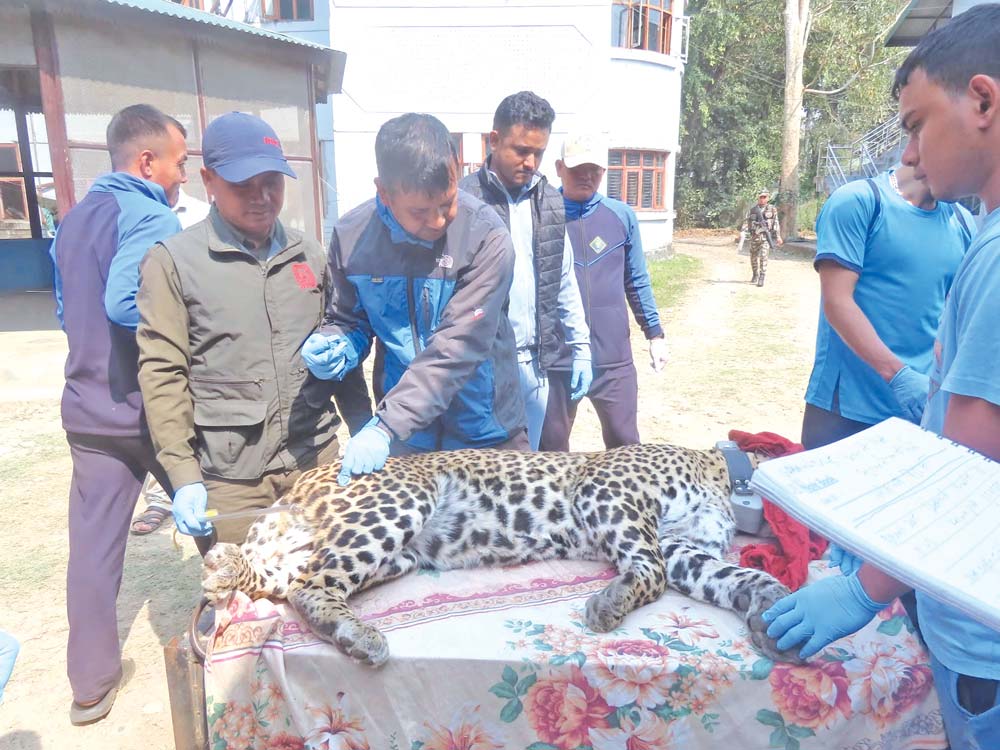- Monday, 29 December 2025
Country accords priority for wildlife rescue
Kathmandu, Aug. 7: More than 600 wild animals were rescued from various parts of Nepal during the fiscal year 2024/25, according to the National Trust for Nature Conservation (NTNC).
The rescued animals ranged from large mammals such as tigers and elephants to reptiles, birds, and snakes, highlighting the growing need for rapid response as human-wildlife encounters increase across the country.
NTNC field offices played a vital role in carrying out these rescue operations in protected areas across the Tarai lowlands, the Kathmandu Valley and high-mountain conservation zones, including Annapurna, Manaslu and Gaurishankar, said Dr. Naresh Subedi, Member Secretary at NTNC. He said that over Rs. 20 million will be invested annually in wildlife rescue operations.
“There are two types of rescues. The first involves tigers and leopards -- often old or injured -- spotted near settlements via camera traps. The second type follows complaints from locals. When villagers see problematic animals near their homes, they report them to security forces, forest officials, or the Department of National Parks and Wildlife Conservation (DNPWC). These authorities then notify NTNC, and our technical rescue team, usually including a veterinarian, is dispatched to handle the situation.”
A dedicated Wildlife Rescue Team (WRT), also known as a Rapid Response Team, is established in every protected area (PA) and its buffer zone for the capture and rescue of wild animals. Each WRT includes veterinarians, wildlife technicians and officers, mahouts, security personnel, drivers and local representatives such as municipal officials and buffer zone user group members. The teams are equipped with essential field gear and rescue equipment.
WRTs are trained in species identification, animal tracking, behaviour analysis, and conducting rescue operations in all types of habitats. They must also effectively coordinate with local communities and ensure the safety of the rescue team, nearby residents, and the wild animal involved.
“There are five primary rescue units -- based in Bardiya, Shuklaphanta, Koshi Tappu, Chitwan, and the Central Zoo -- which are mobilised across the country when needed. Each team includes an ambulance and an animal cage,” Dr. Subedi said.
“So far this year alone, we have rescued 15 tigers. While we address cases involving problematic tigers and leopards, Nepal still lacks an international-standard rescue and rehabilitation centre,” he said. “We currently rely on holding centres, which are not ideal for such large carnivores. After treatment, these animals must either be released into the wild or taken to the Central Zoo -- there are no other options.”
Dr. Subedi added that construction of proper rescue and rehabilitation centres has recently begun in Barandabhar Forest, Shuklaphanta, and Bardiya, through a joint effort by NTNC, the Zoological Society of London (ZSL), and DNPWC. “However, these centres alone will not be enough,” he said.
He also emphasised that human-wildlife conflict has been on the rise in recent years and can only be effectively managed through proactive habitat management, behaviour change, and timely relief distribution to affected communities.
Conservation officer at NTNC Gobinda Pokharel added that most human-wildlife conflict outside national parks and buffer zones is caused by elephants, due to their wide-ranging foraging behaviour. “Elephants travel long distances, whereas tigers and rhinos have smaller home ranges, so conflicts with them tend to be more localised,” he said. In the present days, monkeys and wild boars are also causing conflict, he added.
According to Pokharel, wildlife rescues are carried out under a variety of conditions, including habitat displacement, injuries from traps and snares, escapes from captivity, confiscation of illegally held wildlife, disease, natural disasters, mismothering, and animals falling into wells, canals, or swamps or becoming trapped in food packaging.
113 rescued in Chitwan-Parsa landscape
In the biodiversity-rich Chitwan-Parsa Landscape, NTNC’s Biodiversity Conservation Centre (BCC) led the country’s largest rescue effort with 113 operations involving 36 species.
Rescued wildlife included -- 12 mammal species, including seven Bengal tigers (6 captured, 1 released), 15 wild elephants (rescued for nuisance control, treatment, and radio-collaring), 16 one-horned rhinos (including orphans and those treated or radio-collared), six bird species, six reptile species and 12 snake species.
These operations were conducted in coordination with national park authorities and veterinary experts. Many of the animals were rehabilitated and released after treatment.
In Gaurishankar Conservation Area, 41 animals of 10 species were rescued. In the high Himalayas of the Gaurishankar, 41 animals representing 10 species were rescued. Among the most notable was the Himalayan Monal (Danphe), Nepal’s national bird, which was handed over to the Central Zoo. Some rescued animals were released, while others died due to injury or poor health.
In Koshi Area, 106 individuals from 11 species were rescued including 30 pythons, 18 venomous snakes, 11 mugger crocodiles, 16 bird species, four turtles, one tiger and one elephant Rescue teams in this eastern Tarai area responded to both live rescue operations and the recovery of dead animals for further study, Pokharel said.
Similarly, in Shuklaphanta, leopards, crocodiles, pythons and a vulture were rescued including 25 baby mugger crocodiles and one adult, five common leopards (one found dead, others rescued in weak or injured condition), one tiger found weak and treated, five Burmese pythons and one Himalayan vulture, according NTNC.
These rescues reflect both the park’s rich biodiversity and the growing overlap between human settlements and wildlife habitats, Pokharel said.
Pokharel said many rescued animals were treated at NTNC facilities or in collaboration with the DNPWC. Animals deemed fit for release were returned to the wild, while others remained under special care or were transferred to designated centres.
Beyond rescue operations, NTNC is also actively monitoring problematic animals and working with communities in high-conflict zones to promote wildlife-friendly behaviour. This approach aims to reduce negative interactions and foster peaceful coexistence between people and wildlife in shared landscapes.

















